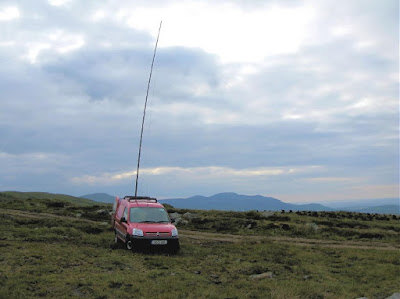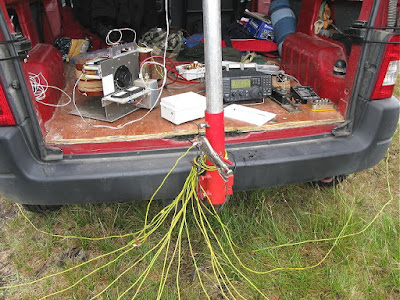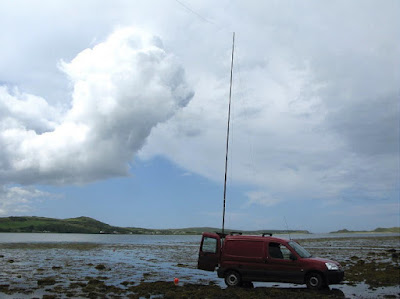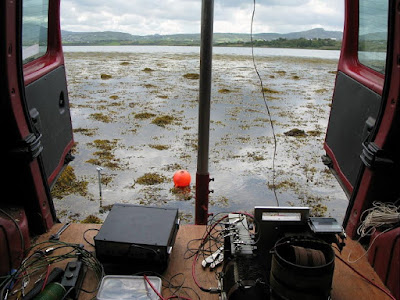 Amateur Radio Weekly – Issue 218
Amateur Radio Weekly – Issue 218
Preparing Ham Radio response to Hurricane Florence
Amateur radio emergency communications groups throughout North and South Carolina and surrounding areas are gearing up for a possibly massive impact on communications infrastructure.
CQ Newsroom
How to listen to Hurricane Watch Net frequencies
The Hurricane Watch Net is a group of amateur radio operators who are trained and organized “to provide essential communications support to the National Hurricane Center during times of Hurricane emergencies.”
The SWLing Post
Worldwide refractive index forecasts
Maps are fully customizable and show refractive index from 80° S to 80° N worlwide.
Beyond the Horizon
[PDF] Introduction to Amateur Digital Television
High-Definition, Digital, Amateur Television — Confirmation photo showing an image received over a distance of 77 miles using a 3 watt, DVB-T transmitter.
KH6HTV
ARRL September VHF 2018 results
Rain on Saturday, Cloudy and Dry on Sunday. Good fun but exhausting.
K5ND
Electronics concept posters
We’ve covered Ohm’s Law, Alternating Current vs Direct Current and Analog and Digital Signals. Each poster is high-resolution and ready to print out up to 24″ x 36″.
SparkFun Electronics
Virtual serial port options for Ham Radio operators
For Hams looking for a reliable solution to create virtual COM port pairs on Windows.
Eltima
Ham Shack-In-A-Box
With a go box, having all my radios are mounted in a single portable box with the radio gear and power connections set up means I will have much longer to operate – and that much more isn’t left to chance.
Soliloquy Blog
Testing FreeDV: Digital voice over HF
This video shows the 700C mode having the ability to decode with 50% of its carriers removed.
Rowetel
Installing Winlink on a Raspberry Pi
Installing and setting up Pat Winlink on a RPi 3.
KM4ACK
Forwarding WSJT-X QSOs to Ham Radio Deluxe
Setup WSJT-X to forward QSOs to HRD Logbook without having to use additional software. Works with FT8Call too.
K0PIR
Receiving GOES-15,16,17 and Himawari 8 HRIT
In this video we go through the hardware and software needed to receive these gorgeous images and what is contained in the signals we receive.
The Thought Emporium
Video
Get Amateur Radio Weekly in your inbox.
Sign-up here
Amateur Radio Weekly is curated by Cale Mooth K4HCK. Sign up free to receive ham radio's most relevant news, projects, technology and events by e-mail each week at http://www.hamweekly.com.
 LHS Episode #246: The Weekender XV
LHS Episode #246: The Weekender XV
 Welcome to the latest edition of the Linux in the Ham Shack Weekender! In this episode, we talk about upcoming amateur radio contests and special event stations, upcoming open source events, interesting Linux distributions to try, things to do with your ham shack and your weekend, including food, wine, beer, whiskey, music and more. Thank you for listening and hope you have a great couple of weeks.
Welcome to the latest edition of the Linux in the Ham Shack Weekender! In this episode, we talk about upcoming amateur radio contests and special event stations, upcoming open source events, interesting Linux distributions to try, things to do with your ham shack and your weekend, including food, wine, beer, whiskey, music and more. Thank you for listening and hope you have a great couple of weeks.
73 de The LHS Crew
Russ Woodman, K5TUX, co-hosts the Linux in the Ham Shack podcast which is available for download in both MP3 and OGG audio format. Contact him at [email protected].
 SOTA Activation from Teton Pass (W7Y/TT-122)
SOTA Activation from Teton Pass (W7Y/TT-122)
While exploring northwest Wyoming, Joyce/K0JJW and I were looking for a suitable mountain for a Summits On The Air (SOTA) activation. A little bit of research identified Pass Benchmark (W7Y/TT-122) as a good option. This summit is accessed from the Teton Pass trailhead, which is on a paved road (Route 22) heading west out of Jackson. There is substantial parking available at the pass and it appears to be a popular trailhead for hikers and mountain bikers.

The sign at the trailhead refers to this summit as Mount Elly, but I have not found that name on any of my maps or other sources. SOTA refers to it as “Pass Benchmark”.

We hiked south from the pass on an obvious gated road which later turns into a trail. We encountered several groups of hikers and mountain bikers so the trail definitely gets used and is in good shape.

We followed the trail past a radio site (and checked out the various antennas). The good news is the radio site is not on the SOTA summit, so not much chance of radio interference.

We continued south on the trail until we were due west of the summit. There is a marker there for the Black Canyon Trail, which leads off to the south. Don’t follow this trail, instead turn left (east) towards the summit. A few switchbacks will get you to the top in good shape. The one-way distance for the hike was 2 miles with 750 feet of elevation gain. Very pleasant.
On top, we started calling on 146.52 MHz with the Yaesu FT-90 putting 30W into a 3-element yagi antenna. We both worked Sam/WY7EM, Jim/K7AVL and Mick/W7CAT on 2m fm. We also caught WY7EM and W7CAT on 446.0 MHz. Thanks for the QSOs!
73 Bob K0NR
The post SOTA Activation from Teton Pass (W7Y/TT-122) appeared first on The KØNR Radio Site.
Bob Witte, KØNR, is a regular contributor to AmateurRadio.com and writes from Colorado, USA. Contact him at [email protected].
 LHS Episode #245: Down with the Sickness
LHS Episode #245: Down with the Sickness
 Welcome to Episode 245 of Linux in the Ham Shack. In this episode, the hosts discuss the threat of Hurricane Florence, the new PW-Sat2, amateur radio in lunar orbit, FOSSCON 2018, DXVK, Solus, popular topics in Open Source and more. Thanks for listening.
Welcome to Episode 245 of Linux in the Ham Shack. In this episode, the hosts discuss the threat of Hurricane Florence, the new PW-Sat2, amateur radio in lunar orbit, FOSSCON 2018, DXVK, Solus, popular topics in Open Source and more. Thanks for listening.
73 de The LHS Crew
Russ Woodman, K5TUX, co-hosts the Linux in the Ham Shack podcast which is available for download in both MP3 and OGG audio format. Contact him at [email protected].
 Weekly Propagation Summary – 2018 Sep 10 16:10 UTC
Weekly Propagation Summary – 2018 Sep 10 16:10 UTC
Here is this week’s space weather and geophysical report, issued 2018 Sep 10 0413 UTC.
Highlights of Solar and Geomagnetic Activity 03 – 09 September 2018
Solar activity was at very low levels this period. Region 2721 (N10, L=286 class/area Bxo/010 on 09 Sep) emerged near center disk on 08 Sep. This small region exhibited slight growth early on 09 Sep, but was showing signs of decay as of this report and remained inactive.
On 09 Sep, a prominence eruption was observed off the SW limb, beginning at 09/0815 UTC in SDO/AIA 304 imagery and at 09/0824 UTC in 171 imagery. While this event appears to be directed well south and west of the Sun-Earth line, significant gaps in SOHO coronagraph imagery data made analysis nearly impossible.
No proton events were observed at geosynchronous orbit.
The greater than 2 MeV electron flux at geosynchronous orbit reach high levels on 03 – 08 Sep, then decreased to moderate levels on 09 Sep. A peak flux of 12,435 pfu was observed on 03/2035 UTC.
Geomagnetic field activity was at quiet to unsettled levels from 03 – 09 Sep, with an isolated period of active conditions on 05 Sep, likely due to a negative polarity coronal hole. Solar wind speeds began the period near 325 km/s, increased to over 500 km/s on 05 Sep and 07 Sep, and ended the period near 400 km/s. Total field strength averaged near 5 nT, and saw a peak of 11 nT on 07 Sep. The Bz component was variable through the period and saw a maximum southward deflection of -6 nT.
Forecast of Solar and Geomagnetic Activity 10 September – 06 October 2018
Solar activity is expected to be at low levels throughout the outlook period, with a slight chance for C-class flare activity.
No proton events are expected at geosynchronous orbit.
The greater than 2 MeV electron flux at geosynchronous orbit is expected to be at moderate to high levels through period. Moderate levels are expected from 10 – 12 Sep and again from 29 Sep – 06 Oct. High levels are expected from 13 – 28 Sep.
Geomagnetic field activity is expected to be at quiet to active levels on 10 Sep. Conditions are then likely reach G2 (Moderate) geomagnetic storm levels on 11 Sep due to a positive polarity coronal hole high speed stream (CH HSS). G1 (Minor) geomagnetic storm levels are also likely on 12 Sep as CH HSS effects persist. Active levels are expected on 13, 14, and 22 Sep from the influence of recurrent CH HSSs. Field activity is expected to be at quiet to unsettled levels throughout the remainder of the outlook period.
Don’t forget to visit our live space weather and radio propagation web site, at: http://SunSpotWatch.com/
Live Aurora mapping is at http://aurora.sunspotwatch.com/
If you are on Twitter, please follow these two users: 1. https://Twitter.com/NW7US 2. https://Twitter.com/hfradiospacewx
– – – – – – – – – – – – –
Be sure to subscribe to our space weather and propagation email group, on Groups.io
https://groups.io/g/propagation-and-space-weather
Spread the word!
– – – – – – – – – – – – –
Links of interest:
+ Amazon space weather books: http://g.nw7us.us/fbssw-aSWSC
+ https://Twitter.com/NW7US
+ https://Twitter.com/hfradiospacewx
Space Weather and Ham Radio YouTube Channel News:
I am working on launching a YouTube channel overhaul, that includes series of videos about space weather, radio signal propagation, and more.
Additionally, I am working on improving the educational efforts via the email, Facebook, YouTube, Tumblr, and other activities.
You can help!
Please consider becoming a Patron of these space weather and radio communications services, beginning with the YouTube channel:
https://www.patreon.com/NW7US
The YouTube channel:
https://YouTube.com/NW7US
..
Visit, subscribe: NW7US Radio Communications and Propagation YouTube Channel
 QRP from the Lifeguard’s Chair
QRP from the Lifeguard’s Chair
Tim W3ATB and I went to Ellacoya State Park in Gilford New Hampshire today. He did a Parks on the Air activation… I sat in the lifeguard’s chair and worked France!
The beach is on Lake Winnipesaukee with a gorgeous, expansive view of the surrounding mountains. I saw this lifeguard’s chair and I couldn’t resist. It was under a huge pine tree. So while Tim was 30 yards away working stations for his POTA activation, I heaved a line into a pine tree above the orange high seat.
As soon as I turned on the KX3, I heard Bert F6HKA in France finishing up a QSO. What a hoot! He came back and gave me a 549. I was thrilled.
I called over to Tim and he worked Bert right after I did. I dismantled my station and went over to Tim’s picnic table to help out if I could. We had a lovely picnic lunch at the park and Tim made his ten contacts for the POTA activation.
P.S. Thanks to Tim for the great photos. His account of the outing is here:
https://w3atb.com/ellacoya-state-park-pota-activation-k-2651/
Jim Cluett, W1PID, is a regular contributor to AmateurRadio.com and writes from New Hampshire, USA. Contact him at [email protected].
 The 630m Portable Adventures of EIØCF
The 630m Portable Adventures of EIØCF

In the years before amateurs in the UK had access to the 630m band as we know it today (472-479kHz), hams there could apply for a 'special research permit' allowing them to operate between 501 and 504kHz.
One of the first and most active stations was operated by Finbar O'Connor, EIØCF, located in the most northern part of Ireland, near Malin Head. In the early days, Finbar might as well have been AC4YN in Lhasa, Tibet, as a 630m or a 2200m QSO with EIØCF was a much prized DX trophy and a genuine 'right of passage' for many little backyard LF and MF stations throughout Europe.
Nowadays, 630m activity in Europe is not as robust as it once was but Finbar is still active on MF from his modest station. He reports being copied in North America on several occasions. Although mainly active in the WSPR mode, Finbar is now considering the two-way JT9 weak signal QSO mode and may hopefully once again, tease east coast North American MF operators with a new rare entity from his seaside location.
 |
| Finbar's WSPRlite setup for 630m |
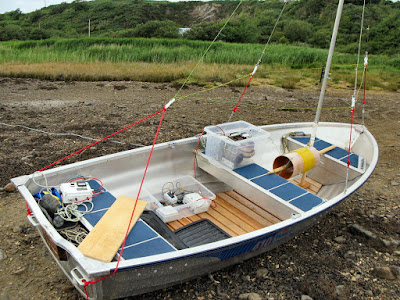 |
| EI0CF/marine on 630m! |
What follows is a delightful adventure, in Finbar's own words, describing some of his field trips back in the 500kHz experimental days ... perhaps it will inspire some North American portable work or provide ideas for an emergency prep 630m grab-and-go kit, or just get you excited about our newest amateur allocation.
******************
Operating Portable on 501 - 504 khz Medium Wave
Operations on the north flank of Slieve Snacht Inishowen Peninsula.
In June 2009 Ireland joined a growing number of countries permitted to operate on a small portion of the medium wave band, just below the commercial broadcast segment, in the range 501 - 504 khz. Several stations were granted permission and operations commenced. As has been documented elsewhere many stations have been worked, both in band and cross band, at home and abroad, ranging from Continental Europe, across the Atlantic to the USA and Canada, down to the southern end of Ukraine and finally up to Iceland, Norway, Sweden, Finland and also being heard in Moscow.
A notable feature of this band is the steady reliable nature of groundwave coverage and with this in mind I recently availed of the facility whereby portable operations can take place. Comreg, together with the IRTS and the individual involved, require that each event is applied for, giving relevant dates, location, contact details, hours of operation and the power of the transmitter being used.
In the period leading up to all this it was necessary to build and test a viable portable station based on the use of my Berlingo van. A 30' part of a 40' Spiderbeam fibreglass pole was used with a simple round wooden peg to secure the 'Tee' wire antenna, which was fabricated from twin twisted multistrand speaker wire. The vertical used both, while the rest was pulled apart to form the two horizontal legs.
A 100 metre roll of 1.5 mm insulated earthing wire was cut into 16 lengths to provide radial wires, with lugs soldered to one end and a bonding bolt used to secure a single point for the radial kit. The far ends formed a small loop which was sealed and secured with insulating tape. The loop provided an eye for a small L shaped stiff wire, fashioned from discarded coat hangers, an ideal and cheap way to hold the ends of the radial wires in place in the ground.
To secure the antenna support to the van, I refer you to the excellent idea described by John EI7BA, on his web page, for a ball hitch connection:
http://www.qsl.net/ei7ba/a_ball_hitch_mobile_mount.htm
Using this superb idea, I got the welder out and made one for myself. It worked perfectly.
I now had the support and wire antenna, with a ballpark figure for what might resonate, along with the radial kit. I next needed a dedicated antenna tuning unit. An old variometer and two extra fixed multitap coils were selected. A home made 1 amp ammeter and SWR twin meter unit completed the fit-out. These were all assembled on a base with a handle on the top, making it easy to move around whilst out and about.
The main antenna for 500kHz was disconnected and left floating and the van set up with all this gear, but no transmitter. Instead, my little antenna bridge running off a 9-volt battery provided the necessary signal to start testing for basic resonance.
Whether from sheer good luck or some sub-conscious input, resonance fell within the range of the variometer with only one of the two extra coils in circuit. The relative height and length also play a part in the range of resonance secured. Matching to 50 ohms was then optimized by selecting 4700 pf Mica capacitors using Croc Clip links. The available value ranged from 1 nF to 14 nF.
I have a selection of 500khz transmitters, two of which are to the design of Roger, GW3UEP, who lives 10 miles inland from the coast, in south Wales. His 500khz web site is well worth checking out, containing plans for versions of his 500khz transmitters, test equipment pictures and recordings of 500khz activities.
http://www.gw3uep.ukfsn.org/
One of these was used to put some RF into this first portable style installation, and by arrangement, Roger listened and heard my signal. We delightedly completed a short contact, with my transmitter running just 10 watts.Things were looking good.
One of the very valuable things about portable operations stems from the need to bring together several elements to secure a working radio station, without the usual backup we enjoy from home. Planning is essential. Doing a dry run, i.e. actually physically building the intended station then notating all the gear required and making a list as well as providing backup items, particularly those that which if broken or lost, would render the whole radio station non-viable. This also extends to the operator of the equipment. Will they be warm or cool enough, have shade, food, water and enough needed rest? Always be prepared to abandon the project if safety is compromised, for whatever reason.
Now that I had a viable portable station for 500kHz working, it was time to head off and test both the equipment and myself in the real world, but without any live transmissions taking place.
Several sites were chosen and tested, with particular emphasis placed on remoteness, i.e. high up on mountains or near the sea. All sites worked very well, but those by the sea proved really excellent. Reception of NDB’s (Non Directional Beacons) provided a ready supply of medium to low frequency signals for range testing. I was now itching to “ have a go “ out in the wilds, on 500kHz! Using the method required by Comreg, an application was made for several sites, on specific days.
In early June I loaded up the van with all the gear and headed off for the mountain above Redcastle, County Donegal. Using a narrow track and climbing higher, to about 270 meters, a place was found leading to an old quarry. Typically, it had started to rain. By the time I had erected the support pole, pulled out and secured the top hat wires using light nylon line and deployed the radial wires around and below the vertical drop wire, my trouser ends were very wet!
Plugging in the 12-volt supply, the receiver was very quickly perked up, using the variometer. The Morse key connected to the QTX transmitter and the transmit / receiver switch flicked over. Time to get some RF flowing in the antenna. Sure enough, on key down, the antenna current meter shot right up to 400 mA, but the SWR match was not exactly perfect. Time to work those Croc Clips and start selecting shunt capacitors to find the perfect match. Soon I had that sorted to my satisfaction, with antenna current now up to 550 mA. A quick return to receive showed that Roger, GW3UEP was already tuned up on frequency.
"..... GW3UEP DE EIØCF/P HW K"
He came back straight away! Oh joy, we were on the air on 500, in a remote mountain area, the top of my antenna almost tipping the clouds as they swept past. I was open to the elements, standing at the back door of the van with the tips of my fingers reaching for the knob of my very favourite old Amplidan morse key, snug beside the other bits and pieces of equipment on the van floor!
My logbook, with its pages flapping back and forward in the wind, soon had the first 500kHz portable contact documented. A full hour later, solid steady signals continued at a distance of 250 miles. Proving just how good groundwave signals can be, I terminated communications from the remote portable location, happy with the results. Within 12 minutes I had dismantled the station and was on my way to Moville, along with a strong cup of coffee at the café on the town's main street.
Several other portable operations have since taken place. A number have also occurred at my home location. We live right beside the sea; high tides lap up on to the salt marsh, which is part of the property.
Driving a single earth rod into the sea shore to a depth of 1 metre, with no radials and just a single wire between the rod and the ATU earth, the 1 amp RF meter had its meter needle slamming against the end stop. Lots of antenna current for 15 watts transmitter output power. Those same 15 watts only providing, at best, 550 mA, whilst up on the mountain sites.
Finally, it was thought productive to try a kite-supported antenna from the seashore portable set up. Winds on the day selected seemed strong enough to enable my Delta shape kite to head aloft with a flying line and antenna wire attached. The Berlingo van was driven down on shore, everything connected and tuned up. All was well, or was it?
The receiver now seemed quite dead with no band noise and no antenna current on transmit. Looking skywards I could see nothing. My eye followed the antenna wire heading for deeper water. Then I saw it. The kite had plunged into the sea! The following 30 minutes entailed untangling loads of seaweed with the line wrapped around rocks, barnacles and everything imaginable. What a mess! I almost gave up, but knew that Roger would be coming up on frequency, on sked, in about 15 minutes.
Eventually I managed to get the kite skywards again but by now the wind was acting more unpredictably. I established contact with Roger and he immediately gave me an S 7 report for my 15 watts. This equated to the report I would get from my main station antenna running 100 watts. My single ground rod and 150 feet of wire were doing the business.
We carried on our contact, but what remained became a battle of wits, with a kite constantly diving down and soaring up again. Several times the antenna wire was in part lying on the sea shore and antenna current way down to 200 mA or lower. My left hand was on the variometer tuning knob, tweaking the setting as best as possible, while pulling in the slack to keep the antenna wire off the ground. Feeding the wire out again to a misbehaving kite, I kept keying away with my right hand, keeping Roger updated so he could understand why my signal was changing both in pitch (sudden antenna mis-match conditions) and signal strength.
Luckily he was also making a recording, which proved later to be a fascinating record of a difficult portable antenna and station operation. It’s remarkable how tolerant, despite the wildly changing antenna conditions, the system actually was in practice. Communications were maintained despite all these negative factors and severely decreased radiated power at times.
Several other tests were conducted within these experiments which would have been almost impossible to conduct without the challenges thrown up by my portable operations. To my mind the 501 – 504khz band exhibits a distinct advantage for enhanced groundwave coverage over that available to higher frequencies.
Relatively simple equipment deployed in remote locations, with or without the availability of the power grid, would provide a solid backbone link or network in times of emergency. Transmitter power output was kept deliberately low to ensure that a higher ERP would not mask any possible weakness in the system. I am happy to conclude that Medium Frequency CW proved it’s worth once again.
Already I have further plans to test smaller, more compact portable antenna and earthing systems in more remote locations.
Finbar O’Connor EIØCF Malin, County Donegal.
Steve McDonald, VE7SL, is a regular contributor to AmateurRadio.com and writes from British Columbia, Canada. Contact him at [email protected].





